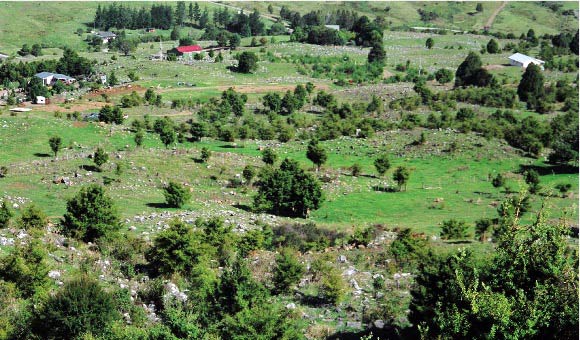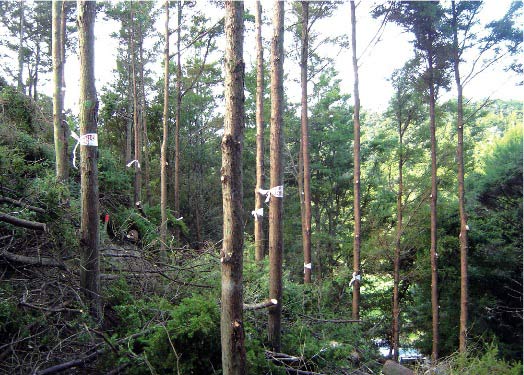Totara – Northland’s farm forests of the future
Helen Moodie, Paul Quinlan, David Bergin and Chris Kennedy, New Zealand Tree Grower November 2007.
Introducing the vision, activities, objectives and profile of the Northland Totara Working Group.
It may be hard for people outside Northland to imagine, but totara are so vigorous and abundant in this region that farmers often consider them firewood at best – or more commonly, weeds. Seedlings can be seen colonising grazed paddocks and growing through fences. Dense thickets, young pole stands, and trees of various shapes and sizes are all common in the scrub or even out in the open pasture. In many parts of Northland totara have now become an ingrained part of the local landscape identity.
To the farm forester these weed-like characteristics are also among the attributes that allow this native tree to occupy a unique place and play a useful and potentially productive role within the farm.
Vision for the land

The Northland Totara Working Group is exploring the potential to change this ‘weed problem’ into an asset for the landowner. While sustainable timber production is a primary focus, the other benefits that come along with the trees are also an important part of the background motivation. These include increasing indigenous biodiversity, erosion control, enhanced soil and water quality, riparian management, landscape and amenity values and of particular interest to the farm forester stock shade and shelter. Management for the productive use of the timber is seen an effective way to achieve those other benefits.
Points of difference with totara compared to many other native trees are:
1. Totara is a pioneer
Totara is a light demanding species. It produces seed from a young age, germinates successfully in grazed pasture, and compared to other New Zealand podocarps, is relatively fast growing. The extensive conversion of forest to pastoral farming has probably assisted in its current proliferation particularly on hill country landscapes and along riparian areas
2. Regenerating totara are stock proof
Totara is relatively unpalatable to most farm stock. It is likely that grazing may be assisting the establishment of totara on farms. This attribute allows an opportunity to integrate a native tree species within a livestock grazing system.
3. Abundant natural regeneration
Rather than relying on planting, totara can successfully colonise grazed environments, especially poorer quality pasture areas and steeper slopes. On many farms in Northland, totara now dominates the character of scrub cover and farm landscapes.
Finding ways to work with this abundant natural regeneration has many attractions. It is a constant natural process occurring without human effort. There are no planting, spraying or fencing costs. There is likely to be no immediate loss of significant grazing as totara often grows on less productive grass sites such as steep hillsides.
Another attraction relates to its scale. Many farms have small and not so small patches of totara and collectively they may add up to a significant regional resource. Opportunities to buy time are few and far between – but use of the existing totara resource is just that.
How much totara is there on farms?
A pilot study survey is presently underway to evaluate the totara resource on Northland farmland. This project, funded by ASB Community Grants, is being undertaken by Chris Kennedy of Geoinfo Ltd. The main aim is to develop a practical way of estimating the resource of totara on private land.
The pilot survey area focuses on private land in the Whangaroa – some 47,000 hectares. It uses a combination of GIS technology, high resolution aerial photography and ‘ground-truthing’ with sample plots in the field. Data on stocking rates, diameter at breast height, form and volume is all being captured to help build a picture of the existing resource. As a secondary objective, a less reliable estimate of the total regional resource in terms of quantity and quality will be extrapolated from this work, which can be updated and refined as more survey data becomes available from outside the initial study area.
While a full technical report will set out the results when the project is complete, early indications are confirming what many of us believed – that the resource out there on private land is significant. Some trees are already of a harvestable size and form.
Some sustainable regional production could be started now, with significantly more coming on in the future.
Management potential
Potential lies in developing the size and quality of the future resource of regenerating totara. Farm grown totara has notoriously poor form especially when grown in open conditions. In contrast, tree form can be very good in natural stands with high stocking rates, although growth rates can be significantly slowed due to competition.
Contrary to a common perception, totara are capable of surprising growth rates on good sites. In managed stands in Kaeo, Paul Quinlan has recorded vigorous individual stems around the 20 to 30cm diameter classes putting on up to 1.76 cm mean annual increment over an eight year period, and around one centimetre mean annual increment for a thinned stand stocked at 575 stems per hectare.
Silviculture to improve growth form

Research trials into the growth response to thinning and pruning and potential to improve tree form is another project currently under way, thanks to funding from MAF’s Sustainable Farming Fund project.
Previous studies indicate that mean annual increment for naturally regenerating totara on these farm sites is about three millimetres where stand densities can be 5,000 stems or more per hectare. Improved growth rates of natural stands are therefore expected to be achieved by thinning.
Stem form of residual trees can also be enhanced by pruning. Research scientist David Bergin has set up silvicultural trials to compare responses to a range of different levels of intervention. Groups of well stocked natural pole stands in three districts in Northland have been thinned to residual stocking rates of 700 to over 2000 stems per hectare. Sometimes this has removed as much as 75% of the stems. In an attempt to cover the wide variation in stocking and composition of regenerating stands, over 40 plots have been established on nine different farms. Control plots, where no pruning or thinning is carried out, are also included for comparisons with treated plots.
Planted stands included
Comparisons with planted totara are also planned. Two of the best performing totara plantations occur in the Northland and Auckland regions. Both stands were planted at densities in excess of 2,000 stems per hectare and have a decreasing mean annual growth rate due to intense competition. Thinning of these plantations will provide an opportunity to compare growth responses to thinned naturally regenerating stands of totara.
Timber quality of young trees
Testing of the timber quality from these relatively young regenerating trees is also intended. Anecdotal evidence suggests that sapwood or transition wood from the young trees still has some fine qualities and is suitable for many uses. Laboratory assessment of wood quality from the thinnings is planned. Sapwood will also be evaluated by carvers from local iwi to determine any differences in qualities compared to traditionally used heartwood totara.
Research results
These are clearly long term projects with the re-measurement and analysis of the trial plots planned over the coming years. At the end of the current three year funding from the Sustainable Farming Fund, preliminary results of this work will be reported and widely distributed. Tane’s Tree Trust, the Far North District Council and the Northland Regional Council are also assisting with the funding of these research trials as are the landowners themselves.
Legal issues around harvesting
There is widespread fear amongst landowners that harvesting of any natives is or will be prohibited by law. Fortunately this is not necessarily the case. The legal rights to harvest can be obtained and members of the working group have successfully done so. However the Forests Act applies to the naturally regenerating totara and this requires commercial harvests to be done on a sustainable basis – planted native trees are exempt from the Act. The Ministry of Agriculture and Forestry’s Indigenous Forestry Unit administer the Forests Act and should be the first port of call if anyone is considering milling any trees.
District Plan rules also apply. The Far North and Whangarei District Plans permit harvests under an approved permit or plan.
So again, a key point is that harvests are possible. Nevertheless the Northland Totara Working Group does make submissions to local authorities and is in dialogue with the Indigenous Forestry Unit concerning the relationship between the unique regenerating totara resource and the various legal issues and processes.
Future projects
We are now looking to address the final objective – to investigate the feasibility of developing a supply chain for sustainably harvested totara regenerating on farms.
There is a lack of market demand or misconceptions of the value of farm grown totara, and on the other, an absence of information on the scale and utility of the resource. A smoothly operating supply chain of material to markets is required.
Totara is not alone in confronting these difficulties, which are complicated by numerous indirect influences such as imported timber prices, and consumer perceptions regarding uses of native timbers. Nevertheless, harnessing the power of the market is a key nut to crack if this resource is to have a significant role in the future sustainable land use of regions such as Northland.
This article is based on the work of the Northland Totara Working Group and prepared by Helen Moodie NZ Landcare Trust, Paul Quinlan Landscape Architect, David Bergin Ensis and Chris Kennedy Geoinfo Ltd.
The who, what and why's
The Northland Totara Working Group is a landowner driven project looking to promote the productive use of farm grown totara. Its scientific foundation is the doctoral thesis of David Bergin which indicated the potential in totara for productive sustainable management. However its strongest base is the significant community support and enthusiasm shown by landowners throughout Northland. Field days and workshops held by the group have been consistently well attended.
Established in September 2005 and convened by Helen Moodie from the NZ Landcare Trust, the group includes local farmers and representatives of the NZFFA branches, Far North District Council, Northland Regional Council, wood millers and processors, Tane’s Tree Trust, NZ Forest Owners Association, and Ensis.
Interest in the project from the Northland community is very high, providing the crucial basis for the initiatives of the working group. The group maintains a database of people interested in hearing about progress of the projects underway. Anyone keen on inclusion in this database should contact Helen Moodie on 09 435 3863 or Helen.moodie@landcare.org.nz.

 Farm Forestry New Zealand
Farm Forestry New Zealand